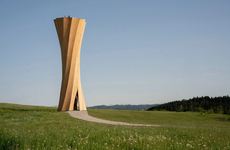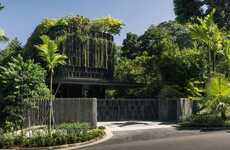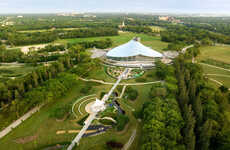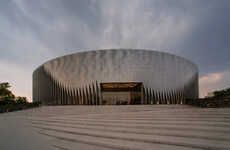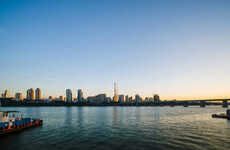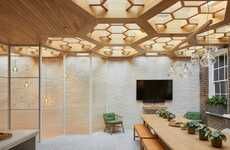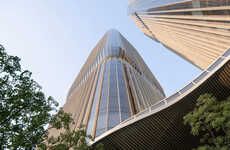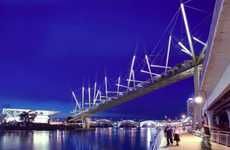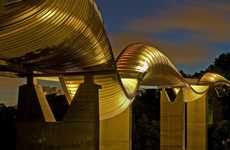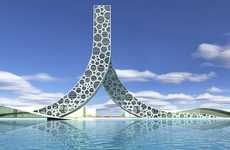
The Gherkin and The Swiss Re Tower in London
Emily A. Davidson — November 27, 2009 — Eco
References: fosterandpartners
Lord Foster completed 30 St. Mary Axe in 2004 in London’s financial district, but its design just turned half a billion years old. Fondly nicknamed The Gherkin and The Swiss Re Tower, the cone-like shape of 30 St. Mary Axe stretches 180 metres tall, holds 40 floors, and its steel exoskeleton dons stripes of navy coloured, diamond-shaped pre-fabricated glass panels. The panels wrap the building in a swirl of windows. 30 St. Mary Axe offers a fascinating example of biomimetic architecture. Biomimetic architecture borrows designs from biological organisms.
The Hexactinellid Euplectella aspergillum, or Venus’ Flower Basket (or sea sponge), features a lattice-like exoskeleton of hexatinellid sea sponges made up of silaceous spicules that look like tiny six-blade propellers. These pile together to build a strong, cylindrical, lattice-like exoskeleton that, because the spicules are made of silicon, appears glassy, traps natural ambient light, and glows.
They call the exoskeleton an organic scaffold. Flexible Silica (silicon) form on the intersecting points of the lattice to “laminate,” or reinforce the overall structure, allowing it to flex under stress, without damaging the core lattice. Two offset lattices allow the outermost structure to flex under stress without compromising structural integrity. The diagonal lattice absorbs bending and torque stress on the exoskeleton.
Also, Venus Flower Baskets gather nutrients from water by filtering water through spaces in the lattice. Flagella found on the inside walls of the Venus Flower Basket swirl the water upwards. In other creatures, the tail-like structures of flagella propel animal sperm during mating.
What does the Euplectella’s structure, and water-filtration techniques have to do with Lord Foster and 30 St. Mary Axe?
The steel exoskeleton of 30 St. Mary Axe mimics the hexactinellid lattice of the Euplectella. Opening windows allow natural light and fresh air to penetrate the structure. The building’s curves allow wind to easily whip around its shape. (Rectangular buildings deflect wind down, blasting anyone at street level on a windy day.) Also, vents at street level harvest wind by sucking it in and swirling air upwards. Beams radiate from the centre of the structure to support each floor. A hole in each floor called an atrium exposes the beams. This cuts the air conditioning bill by 50%.
What the Venus Flower Basket does underwater, 30 St. Mary Axe mimics high in the air, and showing how nature models efficient design, even if it resembles a towering innuendo.
The Hexactinellid Euplectella aspergillum, or Venus’ Flower Basket (or sea sponge), features a lattice-like exoskeleton of hexatinellid sea sponges made up of silaceous spicules that look like tiny six-blade propellers. These pile together to build a strong, cylindrical, lattice-like exoskeleton that, because the spicules are made of silicon, appears glassy, traps natural ambient light, and glows.
They call the exoskeleton an organic scaffold. Flexible Silica (silicon) form on the intersecting points of the lattice to “laminate,” or reinforce the overall structure, allowing it to flex under stress, without damaging the core lattice. Two offset lattices allow the outermost structure to flex under stress without compromising structural integrity. The diagonal lattice absorbs bending and torque stress on the exoskeleton.
Also, Venus Flower Baskets gather nutrients from water by filtering water through spaces in the lattice. Flagella found on the inside walls of the Venus Flower Basket swirl the water upwards. In other creatures, the tail-like structures of flagella propel animal sperm during mating.
What does the Euplectella’s structure, and water-filtration techniques have to do with Lord Foster and 30 St. Mary Axe?
The steel exoskeleton of 30 St. Mary Axe mimics the hexactinellid lattice of the Euplectella. Opening windows allow natural light and fresh air to penetrate the structure. The building’s curves allow wind to easily whip around its shape. (Rectangular buildings deflect wind down, blasting anyone at street level on a windy day.) Also, vents at street level harvest wind by sucking it in and swirling air upwards. Beams radiate from the centre of the structure to support each floor. A hole in each floor called an atrium exposes the beams. This cuts the air conditioning bill by 50%.
What the Venus Flower Basket does underwater, 30 St. Mary Axe mimics high in the air, and showing how nature models efficient design, even if it resembles a towering innuendo.
Trend Themes
1. Biomimetic Architecture - Opportunity for architects to incorporate biological designs and mimic natural structures in their architectural projects.
2. Exoskeleton Structures - Potential for using exoskeleton-like structures in building designs to enhance flexibility, structural integrity, and energy efficiency.
3. Natural Light and Ventilation - Emphasis on incorporating opening windows and ventilation systems in buildings to maximize natural light and fresh air.
Industry Implications
1. Architecture - Architects can explore biomimetic approaches to design innovative and sustainable buildings.
2. Construction - Construction industry can adopt new construction techniques that utilize exoskeleton structures for enhanced efficiency and durability.
3. Renewable Energy - Opportunity to develop and implement wind harvesting systems in buildings to supplement energy needs.
5.7
Score
Popularity
Activity
Freshness


